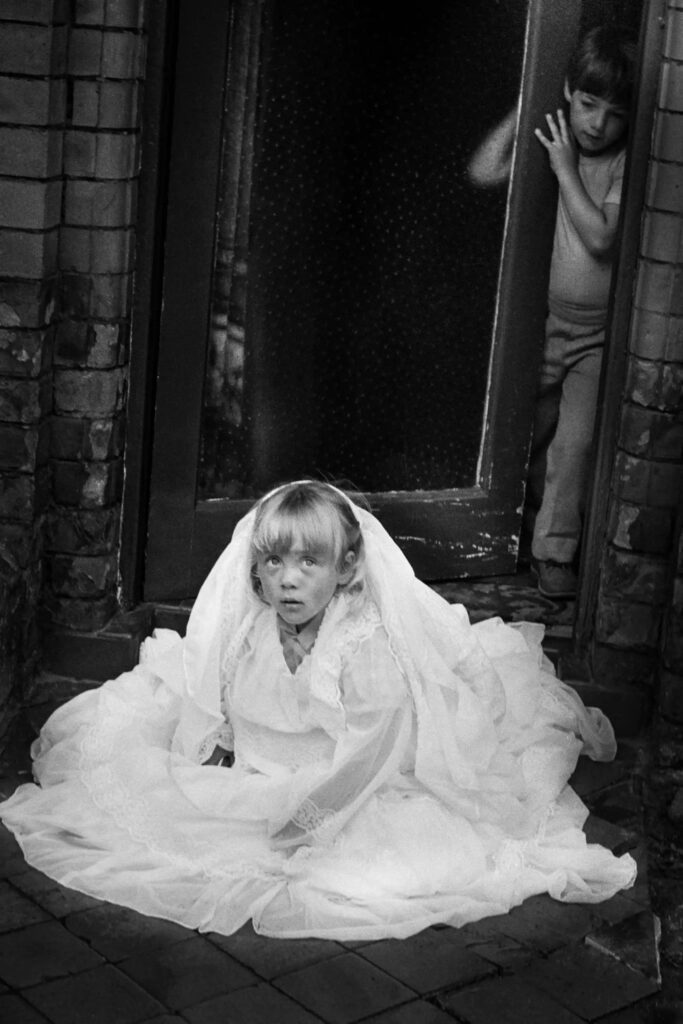2 – 5 October 2025
Preview: 2 October 2025 | 7-9 PM
Ragged School Museum
46-50 Copperfield Road
London E3 4RR
 Markéta Luskačova, Joanna Campbell in her mother’s wedding dress with her brother Clark, Belfast, 1986.
Markéta Luskačova, Joanna Campbell in her mother’s wedding dress with her brother Clark, Belfast, 1986.
Presented within the Ragged School Museum, the exhibition “Resonant Bodies: Beauty in Trouble*” convenes eight contemporary artists to perform the site as an architecture of charged affect and contested social history. Established by Dr Barnardo in 1877, the Copperfield Road Ragged School (or Copperfield Road Free School) was a classic example of the Ragged School movement, which provided free education, food, and basic welfare to the most impoverished children of London’s East End.
As a sonnet to the embedded resonances of lives and realities shaped by the site—the pains, intimacies, struggles, rhythms, and weights—the historical building is considered curatorially as a vessel and a carrier of deep memory, bearing the psychic and bodily residues of lives and histories, rather than a backdrop. In this sense, the Ragged School emerges not only as an architecture of affect and contested social history but also as a container—an archive of loss, repression, fragile survival, resilience, and hope. The exhibition performs a site of transference, in which the constellation of artists and their practices inflects the latent energies within the site’s complex fabric and history.
The children who once passed through these rooms were among the most socially excluded: many lived in conditions of destitution, homelessness, and neglect; some were engaged in child labour, deprived of parental care, or marked as unfit for state schools on account of their ragged clothing, poor hygiene, or so-called anti-social behaviour. The site resonates with the palpable weight of lives, rhythms, fatigue, longing, resolve, and attentiveness of the children who moved through it, carrying hunger, vulnerability, and resilience in equal measure. Evidently, the space embodies the institutionalisation of care itself: a material and affective terrain in which protection, discipline, and longing coexisted, and where the presence of those who were socially excluded, impoverished, or deemed unfit for state schools remains inscribed. “Resonant Bodies: Beauty in Trouble” situates itself within the transference of the weight and aura of such unresolved affective and political agendas and the generative and restorative potential for reintegration.
The artists’ distinctive works unfold across intimate, social, pedagogical, and political registers, conjuring the psychological gravity, bodily intimacy, and layered, often contrary agendas of radical and institutional care. They engage with loss and care, grief and resilience, discipline and vulnerability, labour and violence, longing and solidarity, deprivation and endurance, and the pursuit of dignity through rights. Each artist’s practice unfolds its own temporal, material, political and affective logic—whether through subtle gestures, immersive interventions, formal explorations, or confrontational polemics. The exhibition resists a singular interpretive framework, allowing those diverse practices to coexist as tangential states of being, individually manifesting through profoundly powerful modes of attention, observation, embodiment, hauntedness, and confrontation.
*Beauty in Trouble derives from Hodgson’s renowned poem, “The Bells of Heaven,” circa 1917, which Robert Graves later borrowed as the title of his collection of poetry in 1958.
Resonant Bodies: Beauty in Trouble



